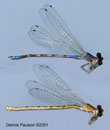
|
|
|||

|
|||
Coenagrionidae: The Pond Damsels
Family Facts:
Genus:
Amphiagrion
There are only
two North American species in this genus, with one being found in Idaho. This
damselfly is the only species in our area that is red and black in color. The
thorax and abdomen are bigger in this species than other members of this family.
Amphiagrion abbreviatum- Western Red Damsel
Genus:
Argia
These damselflies are stream
dwellers. The naiads are shorter and stockier than other members of this family,
and their shape is flattened, which makes it easier for them to crawl under
rocks. The adults are more agile flyers than other members of this family, and
are given the common name Dancers for their buoyant flight style. They prefer
sunny, bare spots for perching, but do not perch for long periods. They can
be distinguished from other members of this family by the length of the spines
on the second joint of the legs. The spines are at least twice as long as the
spaces between the spines. The females oviposit in wet wood, either in tandem
with the male or unattended.
Argia alberta- Paiute
Dancer
Argia emma- Emma's Dancer
Argia vivida- Vivid Dancer
Genus:
Coenagrion
This genus is very similar
to Enallagma, and in fact they share the same common name, the Bluets. The males
are mostly blue and black, while the females can be brown, olive, or colored
like the males. They can be distinguished from Enallagma by the nymphs having
six segments in their antennae rather than seven. The members of Coenagrion
have northerly distributions, and the majority of their range distribution is
in Canada. The one species found in Idaho is usually found at high elevation
lakes and ponds.
Coenagrion resolutum- Taiga Bluet
Genus:
Enallagma
These are the "little
blue damselflies" that are so numerous at weedy ponds. The males are usually
blue banded with black, hence the common name Bluet. The females are either
olive or brown, or are colored similarly to the males, with the exception that
they have more black on the abdomen. Bluets are weak flyers, and are reluctant
to venture far from cover. The nymphs are patterned in green and brown and live
among aquatic vegetation. It's difficult to say what distinguishes this genus
from other genera, as there seems to be more differences between species in
the genus then there are between this genus and genera such as Coenagrion and
Ischnura. It is probable that this genus will eventually be split into several
genera.
Enallagma anna-
River Bluet
Enallagma boreale- Boreal Bluet
Enallagma carunculatum- Tule
Bluet
Enallagma clausum- Alkali Bluet
Enallagma cyathigerum- Northern
Bluet
Enallagma ebrium- Marsh Bluet
Genus:
Ischnura
These damselflies are even
smaller and more slender on average than the Bluets. In the males, the abdomen
is generally solid black above, with the exception of segments eight and nine,
which are bright blue. The sides of the thorax are usually green. The upper
surface of abdominal segment 10 is split, giving these damselflies the common
name Forktails. The females are usually orange to brown in the heterochromatic
form, or they are colored like the males (homeochromatic). The nymphs are very
similar to those of the Bluets, and live in similar habitats.
Ischnura cervula-
Pacific Forktail
Ischnura denticollis- Black-fronted
Forktail
Ischnura perparva- Western Forktail